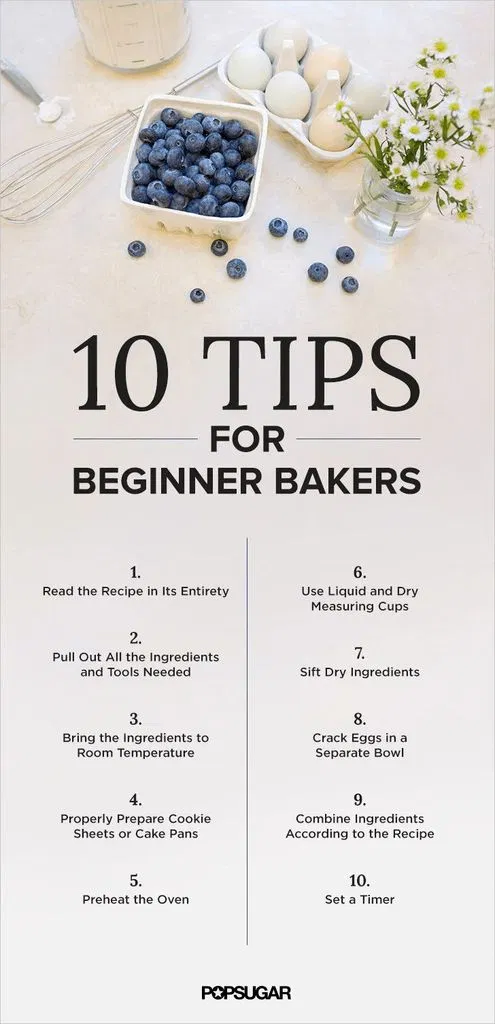Baking Tips
Baking Tips
• STICK TO THE RECIPE. The first and foremost thing you should be remembering, besides the basic ingredients to your recipe, is to always and no matter what blindly following the given recipe. If it asks you to preheat your oven to a 180 degree Celsius, do that! If it asks you to sift your flour, do that! Follow each step and in the respective order the recipe is asking you to. Dessert recipes are actually simple to follow, and they have been tried and tested before being posted, so trust that the order holds a lot of significance. Sticking to recipes is a favor you’ll be doing to your own self!
• Read through your recipe beforehand to allow time for chilling, baking, and cooling.
• Always test your oven temperature and bake time with a small batch before baking entire recipe to ensure perfectly baked goods
• Prepare your ingredients beforehand; allow time for cold or frozen ingredients to defrost to room temperature.
• Bring cold ingredients to room temperature before baking, including eggs unless otherwise stated.
• Measure ingredients correctly using appropriate wet and dry measuring cups or spoons.
• Always use real butter when called for in a recipe.





All Videos
10 Common Mistakes Beginners do in Baking
-
Baking In An Oven Not Yet Preheated Most often people forget to pre-heat the oven. They straight away place the baked goods and preheat them while in there. No, this messes up with the chemistry of baking and can create a total disaster. Wait until the oven is completely preheated before baking.
-
Not Measuring Ingredients Correctly Your ingredient measurements have to be precise to get the chemical reactions you need and to score that perfect, consistent result every time. Be it using metric measures with a cup or spoon, or while using a weighing scale to weigh in grams.
-
Opening The Oven Too Often Opening the oven lets hot air flow out and decreases the temperature of the oven. It could even cause cakes to collapse if you open the oven too often. Unless you're rotating your baked goods or checking for doneness, it's best to observe the baked goods through the window to avoid letting outside air into the oven, which will affect the overall temperature.
-
Your Cake Is Too Dry Or Too Wet Baking for too long will result in a dry cake, while baking too little can result in a mushy center. If your cake comes out dry, poke some small holes in the top and brush the cake with simple sugar syrup, which will permeate the cake and give it some much-needed moisture. If the outside of your cake appears perfectly baked but the center still looks wobbly, decrease the oven temperature by 20-25 degrees celsius, cover the top of your cake with foil, and continue to cook for a few minutes until a toothpick through the middle comes out clean.
-
The Flour Isn't Incorporating Smoothly If your batter or dough is taking on an odd texture (lumpy, uneven, too stiff, too runny), then you could have made either of these mistakes-using the wrong amount of flour (measuring it incorrectly) or not sifting the flour and thereby causing it to become lumpy or mix unevenly.
-
Ingredients Are At Wrong Temperature When a recipe calls for room-temperature butter, milk or eggs, it's important to not bypass the temperature step in order to save time. While it might be tempting to zap your ingredients in the microwave to speed up this process, ultimately that will just result in uneven heat levels and too-high temperatures.
-
Egg Whites Aren't Getting Fluffy If you've been whipping away at your eggs for some time and they're still not developing any kind of peak, there are a few possible issues to blame. Eggs for whipping should be as fresh as possible and at room temperature; cold eggs are unlikely to whip well. As for your whisk and bowl, both should be completely dry before whipping. Any added water can throw off the chemistry of the eggs and prevent them from hardening.
-
Products Are Not Baking Evenly The heat within your oven is unlikely to be perfectly distributed throughout, with certain parts of the oven containing hotter pockets of air. Because of this, if your baked goods remain in the same position throughout the baking process, they will most likely bake unevenly. To avoid this, make sure to rotate your goods at least once throughout the baking process to make sure they're being baked evenly.
-
Cakes Are Not Baking With A Flat Top When making layered or decorated cakes, it's essential that each layer is flat and even. To avoid your cake rising in the center and taking on a domed shape during baking, wrap an even-bake strip or damp towel around the edge of your cake pan, which will prevent the top from rising, and leave you with a smooth, level cake.
-
Cookies Aren't Getting Flat The secret to a perfectly shaped cookie is the temperature. Cookie dough that's too cold will result in rounder, thicker cookies that won't have a satisfying crunch. However, cookie dough that's too warm can spread too much while baking. Allow your dough to rest at room temperature for about 30 minutes before baking, and cook on a tray that is at room temperature, not chilled.




